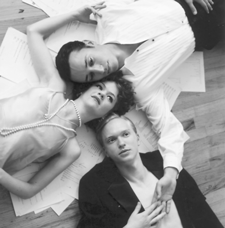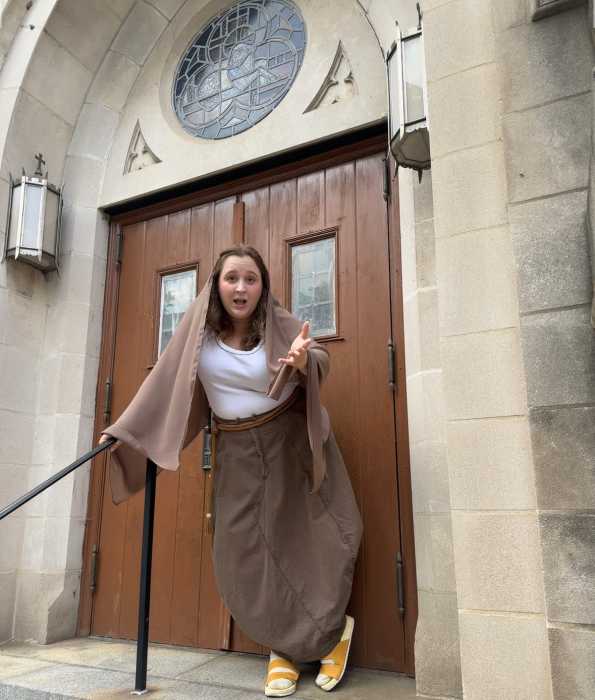At FringeNYC, a warped pas de trois amuses; a bisexual poet galvanizes
In a world where art is routinely trumped by commerce, and where much of New York theater is devolving into safe, mediocre fare designed to placate rather than stimulate, comes FringeNYC to the rescue. Sure, the avant-garde festival, pulsating with some 180 diverse shows, each produced with little more than a credit card and a dream, lives up to its scrappy, hit-or-miss reputation. But that’s part of the fun.
I gambled on two shows that, while far from perfect, displayed such pluck and such unbridled spirit, my palms smarted from applauding. Why fork over $100 for doltish, dancing knights and slavish Elvis impersonators when you can experience real passion for a mere 15 bucks?
Director Scot Ebersold works wonders with “the silent concerto (a comedy about three tragedies),” one of the most complex, ambitious pieces of new theater this side of Anton Chekhov. Written by Alejandro Morales, who clearly has a fetish for the iconic Russian playwright, the play traces the hopes and heartaches of three friends in New York City over the course of a decade, from 1994 to 2004.
But there’s a catch. This is a high-concept piece, a deconstruction, if you will. One character, the “devastatingly charming” Naldo (Ivan Quintanilla), is actually the author struggling to write and re-write the work as the evening progresses. If you don’t know Chekhov’s “The Seagull,” cited here multiple times, then this play-within-a-play conceit may be daunting, if not downright unfathomable.
Nothing’s for sure in this universe. Scene I starts again and again, with a frustrated Naldo reworking the details to get it right. Naldo and wannabe actress Mallory (Susan Louise O’Conner) are college-age roommates and perhaps lovers. Naldo has a crush on the beautiful, incorrigible Benny (Gregory Marcel), who is keen on meeting Chelsea boys, yet may also have the hots for Mallory. Conflicts and conundrums abound.
Morales deftly undercuts this otherwise weighty undertaking with humor. “Keep grabbing me,” Benny says to Naldo in a bar. “Guys are always more interested when you’re with someone else.” When the deliriously caustic Mallory phones Naldo from a bar, seeking advice about hooking up with a married guy, she demands, over the clattering music, “Explain Blues Traveler to me!”
Drinking Absolut vodka from a bottle, the trio end up voguing to the Tori Amos hit, “Crucify Myself,” their unofficial theme song. When the tape gets stuck, Benny laments, “Everything perfect is bound to get fucked, isn’t it?”
In Act II, which takes place two years later, then skips another eight years, the characters are still stuck in Scene I and now read from scripts on music stands, narrating in the third person. Are you with me? Later, with the help of a handgun—and a cassette revealing a secret—our intrepid playwright may finally shake his slump. But to what end?
Like Chekhov, this complex work, with its nuanced layering, probes the shifting edges of drama and reality, and the nature of theater itself. Clearly Morales believes writing plays, despite the anguish, is the noblest of pursuits. “It’s something you do for love,” Naldo professes.
The aim of “the silent concerto,” if I’ve got it right, is to create a story that could pass for memory. If you convince yourself that the memory really happened, then it is real. Perhaps Morales is asking, “Why can’t a play be considered as real as true life?”
Sound pretentious? Maybe just a tad. But it’s absorbing theater, nonetheless.
The set, by Nicholas Vaughan, elegantly captures the work-in-progress aesthetic. White walls are unfinished and translucent, and cardboard moving cartons, packed with possibilities, are randomly strewn about the apartment, waiting to be opened. Often actors switch on mini spotlights, which resemble microphones, as they recite their lines.
Kudos go to Ebersold and the energetic cast for bringing this throbbing morass of material to life. Yet, despite its merits, “silent concerto” may not be music to everyone’s ears. Because much of the play is intentionally stuck in first gear, consequently so is the audience. It’s difficult to keep up, or continue to care, when the rules keep changing. Often the play takes on a bizarre, dreamlike quality—which is fine if you enjoy other people’s dreams.
Less cryptic and every bit as daring is another play with an extended title that eschews capital letters, “edna st. vincent millay speaks to the committee on immortality.” Written and performed by the incomparable Jennifer Gibbs, the solo show offers a tantalizing take on the maverick Pulitzer Prize-winning poet, and imagines her addressing the audience whose job is to judge her legacy.
Like “the silent concerto,” Gibbs is unafraid to explore the juncture between theater and reality. As the show begins, we see a confused, pained Millay, watching stagehands assemble a spare set, consisting of a billowy, cream-colored curtain, a settee, and a vase of flowers. She adds the final touches herself.
Against an ever-changing backdrop of projected images of trees, skies, and birds, the red-haired, small boned Gibbs pleads Millay’s case—clad mostly in silky, sensuous undergarments. “How about this, ladies?,” she teases as she flashes some thigh, reminding us that Millay was as famous for her freedom in sexuality as for her verse.
This inspired show, directed by Marie-Louise Miller, weaves together snippets of Millay’s poetry and letters, along with original monologue crafted so ingeniously you’d swear it was written by the legend herself.
If you’re looking for a straight bio-play that paints a complete portrait of this literary renegade, you’ll be disappointed. For Gibbs is obsessed with Millay’s beautiful language, her motivation, and her hunger for immortality. Details of her life are merely sketched in. We learn that Millay was first published at age 20 for “Renascence,” a groundbreaking poem that should have won first prize in a contest but didn’t. She was a Vassar girl, and a fixture in the Greenwich Village bohemian scene during the Jazz Age. Later, Millay took a husband and enjoyed a most modern, open marriage. She loved her mother, she loved music, but most of all she loved language and the adoration it brought her.
By 1945, thanks to a debilitating car accident, Millay is wreck of a woman, with a taste for “hashish, gin, bad poetry, love, and morphine.” She regularly shoots up throughout the performance, flirting all too dangerously with overdose.
The audience is thoroughly seduced, much as it was in the early 20th century when the literary light toured the country performing readings, like a pop star. Gibbs’ uncanny portrayal through the 90-minute, intermission-less show is utterly mesmerizing.
Why did Millay write poetry? As she puts it, “Something has to be done with one’s passion.” Surely the same can be said about the stunningly gifted Gibbs. And, perhaps, about all the FringeNYC artists, for that matter.
gaycitynews.com




































